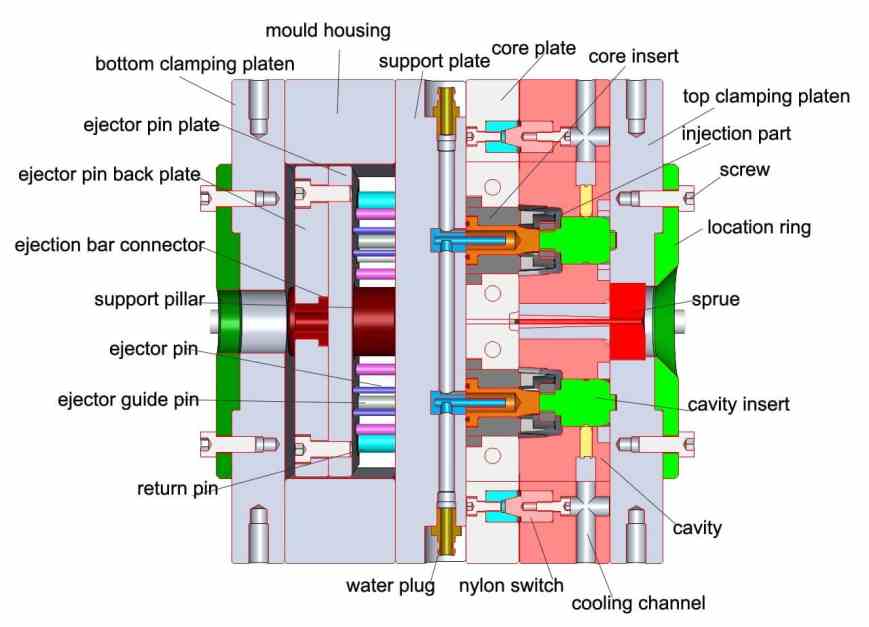Q&A on Injection Molding

- What are the advantages of injection molding over other methods of manufacturing a part?
- Is injection molding expensive?
- In what time frame does a plastic part need to be molded?
- What is the cost of an injection mold?
- Injection mold ownership: who owns it?
- What is the average time it takes to build an injection mold?
- Is it possible to change the design? Is it possible to modify the original injection mold?
- How long does a typical injection mold last?
- Mold cavities: what are they?
- How does a parting line work?
- An injection mold consists of two halves, "A" and "B". How do they differ?
- How does an ejector pin work?
- How does a gate work?
- How does Steel Safe work?
What are the advantages of injection molding over other methods of manufacturing a part?
With injection molding, we can mold fairly complex shapes at high production rates while maintaining good dimensional stability and holding fairly tight tolerances. It is possible to reground and reprocess thermoplastic resin used in injection molding, but some of the plastic's physical properties may be lost over each round of regrinding. When manufacturing large volumes, using engineered plastic resins instead of metal can result in many cost savings.
Is injection molding expensive?
Injection molded parts can cost as little as a few cents to as much as several dollars. For injection molded parts, there are many factors that affect the cost, including the size and complexity of the part, the plastic resin being molded, and the number of cavities in the mold.
In what time frame does a plastic part need to be molded?
Injection molded parts typically have a cycle time of a few seconds to a few minutes. Part size, material being molded, mold design, and part design are all factors that determine this. An average mold set-up time is between a few minutes and a few hours.
The setup and start up time can be absorbed into the cost of the part once a setup is established and the process is stable.
What is the cost of an injection mold?
There are several thousand dollars to a few hundred thousand dollars involved in making an injection mold. It is likely that the complexity of the part as well as its size are the biggest factors contributing to this cost. When building molds, parts with a simple appearance may prove difficult to build since they have undercuts that may require moving parts to move to allow free ejection of the part when the mold is opened.
Injection mold ownership: who owns it?
Most injector molds are owned by customers who design and purchase the parts. Unless specific contract terms are agreed upon, customers usually have the right to have their molds molded anywhere; however, making sure the right equipment and process are available in the new location can present some risks.
What is the average time it takes to build an injection mold?
Injection molds are typically built between a few weeks and a few months. The length of time it takes to manufacture a part depends on many factors, including the backlog of the supplier or the resources he has on hand as well as the complexity of the mold or the number of cavities required in the mold.
Is it possible to change the design? Is it possible to modify the original injection mold?
It depends on how the injection mold was designed in some cases. Injection molds are constructed by inserting steel into a mold base and assembling them together to make the feature of the part. Modifying or rebuilding a small steel insert is all that is required to change one feature of the part. Some design changes can be more challenging when the entire part design is cut out of one piece of steel, requiring reworking the mold.
How long does a typical injection mold last?
SPI Class 101 is the industry standard for mold makers, which guarantees a mold life of 1M shots. You should be able to produce 4M parts from your mold if it has 4 cavities. This amount may vary depending on the part's complexity and the plastic resin used. There is no doubt that your mold will last you well over 1 million shots. In complex parts or if your mold has steel inserts or you're using an abrasive plastic resin, such as polycarbonate or glass filled polycarbonate, mold wear will be more progressive, resulting in shorter mold lives.
Mold cavities: what are they?
Injection molds have cavities that form parts. It is possible to have one cavity in an injection mold or multiple cavities, each with a different part or a family of different parts. By making multiple parts during one molding cycle, the injection mold cost will be higher, but the injection molded parts will be cheaper.
How does a parting line work?
The parting line is the line where two injection mold halves meet. The molded part usually bears a witness line indicating where the mold was parted. SOccasionally, a parting line may be stepped rather than flat.
An injection mold consists of two halves, "A" and "B". How do they differ?

Known as "A" half, this half of the injection mold is stationary in the machine while plastic is injected into it. In the "B" half, the mold opens and closes by moving back and forth. A part ejected from the "B" half of the mold is ejected when the mold is opened.
How does an ejector pin work?
Parts are actually pulled off of the mold by these pins. Mold cavity surfaces on half "B" are drilled with holes, and steel pins are ground flush with those surfaces. Another plate (known as the "Knock Out Plate") connects the other ends of the pins. Injection molds are opened by the injection machine, which pushes a steel bar (called the "Knock Out Bar") forward. To eject the part, all ejector pins are moved forward simultaneously to push the knock out plate forward.
How does a gate work?
Gates are openings in injection mold cavities through which plastic flows.
For injection molded parts, what tolerances are possible?
It is not uncommon for plastic parts to be held within .001 of an inch of tolerance. Variations in plastic materials can be controlled more easily in some materials than others.
As a result of advancements in injection molding technology, injection molding machines today produce relatively accurate and repeatable results. If you want to maintain six sigma quality and have a tolerance window of .002 of an inch, you may be pushing the limits since gauge measurements and other factors may throw off your statistical results. The shrinkage of some plastic resins, however, is predictable and easier to control from part to part.
How does Steel Safe work?
Mold makers must consider plastic shrinkage when building injection molds. As an example, if he was to construct an injection mold for a plastic part with a shrinkage rate of .003 in./in. A 1.003 inch mold core would be required if the inside diameter of the mold needed to be 1 inch.
To allow for shrinkage, the diameter should be smaller. Since he could always remove steel to make the core smaller after molding the part if needed, he built the core slightly over size in order to leave room for error (whether it was in measurement or shrinkage).
By building the mold core over to fix a too small part, it would require a lot more work to fix the problem than simply adding steel to the mold core. The cavity of the mold would have to be small if we wanted to control the outside diameter.
https://www.plasticmoulds.net/qa-on-injection-molding.html?feed_id=371&_unique_id=62e3268a7688f
Comments
Post a Comment